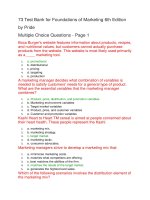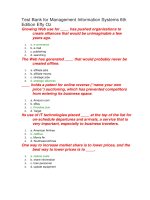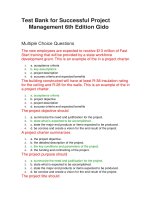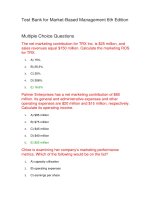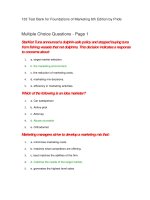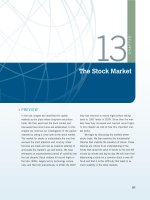Test bank financial markets and institutions 6th edition saunders
Bạn đang xem bản rút gọn của tài liệu. Xem và tải ngay bản đầy đủ của tài liệu tại đây (619.74 KB, 58 trang )
Test Bank Financial Markets and Institutions 6th Edition Saunders
Test Bank Financial Markets and Institutions 6th Edition Saunders
Chapter 01
Introduction
True / False Questions
1.
Primary markets are markets in which users of funds raise cash by selling securities to funds'
suppliers.
True
False
2. Secondary markets are markets used by corporations to raise cash by issuing securities for a
short time period.
True
False
1-1
Test Bank Financial Markets and Institutions 6th Edition Saunders
3.
Corporate security issuers are always directly involved in funds transfers in the secondary
market.
True
False
4.
The New York Stock Exchange (NYSE) is an example of a secondary market.
True
False
5.
Central governments sometimes intervene in foreign exchange markets by affecting foreign
exchange rates indirectly through raising or lowering interest rates.
True
False
6.
Money markets are the markets for securities with an original maturity of one year or less.
True
False
7. Financial intermediaries such as banks typically have assets that are riskier than their liabilities.
True
False
8. There are three types of major financial markets today: primary, secondary, and derivatives
markets. The NYSE and NASDAQ are both examples of derivatives markets.
True
False
1-2
Test Bank Financial Markets and Institutions 6th Edition Saunders
Multiple Choice Questions
9.
What factors are encouraging financial institutions to offer overlapping financial services such as
banking, investment banking, brokerage, etc.?
I. Regulatory changes allowing institutions to offer more services
II. Technological improvements reducing the cost of providing financial services
III. Increasing competition from full-service global financial institutions
IV. Reduction in the need to manage risk at financial institutions
A. I only
B. II and III only
C. I, II, and III only
D. I, II, and IV only
E. I, II, III, and IV
1-3
Test Bank Financial Markets and Institutions 6th Edition Saunders
10.
IBM creates and sells additional stock to the investment banker Morgan Stanley. Morgan Stanley
then resells the issue to the U.S. public.
This transaction is an example of a(n)
A.
primary market transaction.
B.
asset transformation by Morgan Stanley.
C.
money market transaction.
D.
foreign exchange transaction.
E.
forward transaction.
1-4
Test Bank Financial Markets and Institutions 6th Edition Saunders
11.
IBM creates and sells additional stock to the investment banker Morgan Stanley. Morgan Stanley
then resells the issue to the U.S. public.
Morgan Stanley is acting as a(n)
A.
asset transformer.
B.
asset broker.
C.
government regulator.
D.
foreign service representative.
1-5
Test Bank Financial Markets and Institutions 6th Edition Saunders
12. A corporation seeking to sell new equity securities to the public for the first time in order to raise
cash for capital investment would most likely
A.
conduct an IPO with the assistance of an investment banker.
B.
engage in a secondary market sale of equity.
C.
conduct a private placement to a large number of potential buyers.
D.
place an ad in the Wall Street Journal soliciting retail suppliers of funds.
E.
none of the options.
13. The largest capital market security outstanding in 2010 measured by market value was
A.
securitized mortgages.
B.
corporate bonds.
C.
municipal bonds.
D.
Treasury bonds.
E.
corporate stocks.
1-6
Test Bank Financial Markets and Institutions 6th Edition Saunders
14.
The diagram below is a diagram of the
A.
secondary markets.
B.
primary markets.
C.
money markets.
D.
derivatives markets.
E.
commodities markets.
15.
_________ and __________ allow a financial intermediary to offer safe liquid liabilities such as
deposits while investing the depositors' money in riskier illiquid assets.
A. Diversification; high equity returns
B. Price risk; collateral
C. Free riders; regulations
D. Monitoring; diversification
E. Primary markets; foreign exchange markets
1-7
Test Bank Financial Markets and Institutions 6th Edition Saunders
16.
Depository institutions include
A.
banks.
B.
thrifts.
C.
finance companies.
D.
all of the options presented.
E.
banks and thrifts.
1-8
Test Bank Financial Markets and Institutions 6th Edition Saunders
17.
Match the intermediary with the characteristic that best describes its function.
I. Provide protection from adverse events.
II. Pool funds of small savers and invest in either money or capital markets.
III. Provide consumer loans and real estate loans funded by deposits.
IV. Accumulate and transfer wealth from work period to retirement period.
V. Underwrite and trade securities and provide brokerage services.
1. Thrifts
2. Insurers
3. Pension funds
4. Securities firms and investment banks
5. Mutual funds
A. 1, 3, 2, 5, 4
B. 4, 2, 3, 5, 1
C. 2, 5, 1, 3, 4
D. 2, 4, 5, 3, 1
E. 5, 1, 3, 2, 4
1-9
Test Bank Financial Markets and Institutions 6th Edition Saunders
18.
Secondary markets help support primary markets because secondary markets
I. offer primary market purchasers liquidity for their holdings.
II. update the price or value of the primary market claims.
III. reduce the cost of trading the primary market claims.
A. I only
B. II only
C. I and II only
D. II and III only
E. I, II, and III
19. Financial intermediaries (FIs) can offer savers a safer, more liquid investment than a capital
market security, even though the intermediary invests in risky illiquid instruments because
A.
FIs can diversify away some of their risk.
B.
FIs closely monitor the riskiness of their assets.
C.
the federal government requires them to do so.
D.
FIs can diversify away some of their risk and closely monitor the riskiness of their assets.
E.
FIs can diversify away some of their risk and the federal government requires them to do so.
1-10
Test Bank Financial Markets and Institutions 6th Edition Saunders
20.
Households are increasingly likely to both directly purchase securities (perhaps via a broker) and
also place some money with a bank or thrift to meet different needs. Match up the given
investor's desire with the appropriate intermediary or direct security.
I. Money likely to be needed within six months
II. Money to be set aside for college in 10 years
III. Money to provide supplemental retirement income
IV. Money to be used to provide for children in the event of death
1. Depository institutions
2. Insurer
3. Pension fund
4. Stocks or bonds
A. 2, 3, 4, 1
B. 1, 4, 2, 3
C. 3, 2, 1, 4
D. 1, 4, 3, 2
E. 4, 2, 1, 3
21.
As of 2013, which one of the following derivatives instruments had the greatest amount of
notional principal outstanding?
A. Futures
B. Swaps
C. Options
D. Bonds
E. Forwards
1-11
Test Bank Financial Markets and Institutions 6th Edition Saunders
22. Which of the following is/are money market instrument(s)?
A. Negotiable CDs
B. Common stock
C. T-bonds
D. 4-year maturity corporate bond
E.
Negotiable CDs, common stock, and T-bonds
23. The Securities Exchange Commission (SEC) does not
A.
decide whether a public issue is fairly priced.
B.
decide whether a firm making a public issue has provided enough information for investors to
decide whether the issue is fairly priced.
C.
require exchanges to monitor trading to prevent insider trading.
D.
attempt to reduce excessive price fluctuations.
E.
monitor the major securities exchanges.
1-12
Test Bank Financial Markets and Institutions 6th Edition Saunders
24.
The most diversified type of depository institutions is
A.
credit unions.
B.
savings associations.
C.
commercial banks.
D.
finance companies.
E.
mutual funds.
1-13
Test Bank Financial Markets and Institutions 6th Edition Saunders
25. Insolvency risk at a financial intermediary (FI) is the risk
A.
that promised cash flows from loans and securities held by FIs may not be paid in full.
B.
incurred by an FI when the maturities of its assets and liabilities do not match.
C.
that a sudden surge in liability withdrawals may require an FI to liquidate assets quickly at fire
sale prices.
D.
incurred by an FI when its investments in technology do not result in cost savings or revenue
growth.
E.
risk that an FI may not have enough capital to offset a sudden decline in the value of its
assets.
26. Depository institutions (DIs) play an important role in the transmission of monetary policy from the
Federal Reserve to the rest of the economy because
A.
loans to corporations are part of the money supply.
B.
bank and thrift loans are tightly regulated.
C.
U.S. DIs compete with foreign financial institutions.
D.
DI deposits are a major portion of the money supply.
E.
thrifts provide a large amount of credit to finance residential real estate.
1-14
Test Bank Financial Markets and Institutions 6th Edition Saunders
27. Liquidity risk at a financial intermediary (FI) is the risk
A.
that promised cash flows from loans and securities held by FIs may not be paid in full.
B.
incurred by an FI when the maturities of its assets and liabilities do not match.
C.
that a sudden surge in liability withdrawals may require an FI to liquidate assets quickly at fire
sale prices.
D.
incurred by an FI when its investments in technology do not result in cost savings or revenue
growth.
E.
risk that an FI may not have enough capital to offset a sudden decline in the value of its
assets.
28.
Money markets trade securities that
I. mature in one year or less.
II. have little chance of loss of principal.
III. must be guaranteed by the federal government.
A. I only
B. II only
C. I and II only
D. I and III only
E. I, II, and III
1-15
Test Bank Financial Markets and Institutions 6th Edition Saunders
29.
Which of the following are capital market instruments?
A. 10-year corporate bonds
B. 30-year mortgages
C. 20-year Treasury bonds
D. 15-year U.S. government agency bonds
E.
All of the options
30. Commercial paper is
A.
a time draft payable to a seller of goods, with payment guaranteed by a bank.
B.
a loan to an individual or business to purchase a home, land, or other real property.
C.
short-term funds transferred between financial institutions usually for no more than one day.
D.
a marketable bank issued time deposit that specifies the interest rate earned and a fixed
maturity date.
E.
a short-term unsecured promissory note issued by a company to raise funds for a short time
period.
1-16
Test Bank Financial Markets and Institutions 6th Edition Saunders
31. A negotiable CD is
A.
a time draft payable to a seller of goods, with payment guaranteed by a bank.
B.
a loan to an individual or business to purchase a home, land, or other real property.
C.
a short-term fund transferred between financial institutions usually for no more than one day.
D.
a marketable bank issued time deposit that specifies the interest rate earned and a fixed
maturity date.
E.
a short-term unsecured promissory note issued by a company to raise funds for a short time
period.
Short Answer Questions
32. Discuss how secondary markets benefit funds issuers.
1-17
Test Bank Financial Markets and Institutions 6th Edition Saunders
33. How can brokers and dealers make money? Which activity is riskier? Why?
34. What does an asset transformer do? Why is asset transformation a risky activity?
35. How can using indirect finance rather than direct finance reduce agency costs associated with
monitoring funds' demanders?
1-18
Test Bank Financial Markets and Institutions 6th Edition Saunders
36.
What have been the major factors contributing to growth in the foreign financial markets?
37. You are a corporate treasurer seeking to raise funds for your firm. What are some advantages of
raising funds via a financial intermediary (FI) rather than by selling securities to the public?
1-19
Test Bank Financial Markets and Institutions 6th Edition Saunders
38.
How can a depository intermediary afford to purchase long-term risky direct claims from funds
demanders and finance these purchases with safe, liquid, short-term, low-denomination
deposits? What can go wrong in this process?
39. Discuss the benefits to funds' suppliers of using a financial intermediary asset transformer in
place of directly purchasing claims such as stocks or bonds. What is the major disadvantage?
40. Discuss the major macro benefits of financial intermediaries. What role does the government
have in the credit allocation process?
1-20
Test Bank Financial Markets and Institutions 6th Edition Saunders
41. What determines the price of financial instruments? Which are riskier, capital market instruments
or money market instruments? Why?
42. Explain how the credit crunch originating in the mortgage markets hurt financial intermediaries'
attempts to use diversification and monitoring to limit the riskiness of their loans and investments
while offering more liquid claims to savers.
1-21
Test Bank Financial Markets and Institutions 6th Edition Saunders
Chapter 01 Introduction Answer Key
True / False Questions
1.
Primary markets are markets in which users of funds raise cash by selling securities to funds'
suppliers.
TRUE
AACSB: Reflective Thinking
Accessibility: Keyboard Navigation
Blooms: Remember
Difficulty: Easy
Learning Goal: 01-01 Differentiate between primary and secondary markets.
Topic: Overview of Financial Markets
2.
Secondary markets are markets used by corporations to raise cash by issuing securities for a
short time period.
FALSE
AACSB: Reflective Thinking
Accessibility: Keyboard Navigation
Blooms: Remember
Difficulty: Easy
Learning Goal: 01-01 Differentiate between primary and secondary markets.
Topic: Overview of Financial Markets
1-22
Test Bank Financial Markets and Institutions 6th Edition Saunders
3.
Corporate security issuers are always directly involved in funds transfers in the secondary
market.
FALSE
AACSB: Reflective Thinking
Accessibility: Keyboard Navigation
Blooms: Remember
Difficulty: Easy
Learning Goal: 01-01 Differentiate between primary and secondary markets.
Topic: Overview of Financial Markets
4.
The New York Stock Exchange (NYSE) is an example of a secondary market.
TRUE
AACSB: Reflective Thinking
Accessibility: Keyboard Navigation
Blooms: Understand
Difficulty: Easy
Learning Goal: 01-01 Differentiate between primary and secondary markets.
Topic: Overview of Financial Markets
1-23
Test Bank Financial Markets and Institutions 6th Edition Saunders
5.
Central governments sometimes intervene in foreign exchange markets by affecting foreign
exchange rates indirectly through raising or lowering interest rates.
FALSE
AACSB: Reflective Thinking
Accessibility: Keyboard Navigation
Blooms: Remember
Difficulty: Easy
Learning Goal: 01-01 Differentiate between primary and secondary markets.
Topic: Overview of Financial Markets
6.
Money markets are the markets for securities with an original maturity of one year or less.
TRUE
AACSB: Reflective Thinking
Accessibility: Keyboard Navigation
Blooms: Remember
Difficulty: Easy
Learning Goal: 01-02 Differentiate between money and capital markets.
Topic: Overview of Financial Markets
7.
Financial intermediaries such as banks typically have assets that are riskier than their
liabilities.
TRUE
AACSB: Reflective Thinking
Accessibility: Keyboard Navigation
Blooms: Remember
Difficulty: Easy
Learning Goal: 01-06 Know the services financial institutions perform.
Topic: Overview of Financial Institutions
1-24
Test Bank Financial Markets and Institutions 6th Edition Saunders
8.
There are three types of major financial markets today: primary, secondary, and derivatives
markets. The NYSE and NASDAQ are both examples of derivatives markets.
FALSE
AACSB: Reflective Thinking
Accessibility: Keyboard Navigation
Blooms: Understand
Difficulty: Easy
Learning Goal: 01-01 Differentiate between primary and secondary markets.
Learning Goal: 01-04 Understand what derivative security markets are.
Topic: Overview of Financial Markets
Multiple Choice Questions
1-25
